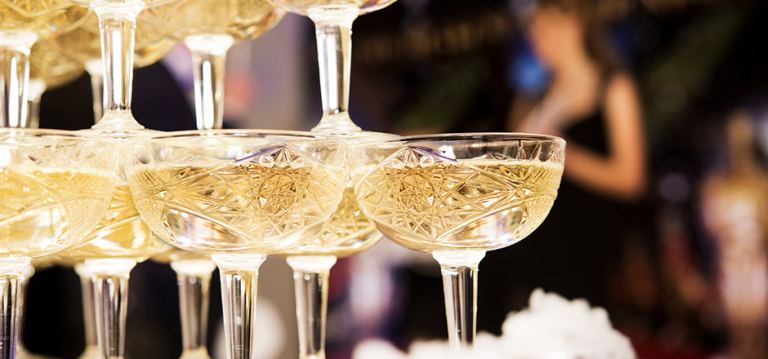

THE GRApe
- The Grape
Everything You Never Knew About Serving Champagne
Read Time 4 Minutes
Posted 31 Aug 2022
By Vintage Cellars
It isn’t a celebration unless the Champagne corks are popping. Here’s everything you need to know about your favourite fizz.
The transition into festive mode usually begins with the Melbourne Cup: the Champagne flows as thoroughbreds thunder down the turf in Australia’s biggest horse race. And that’s just the beginning: from here on out it’s Christmas parties, New Year celebrations and al fresco dinners as far as the eye can see. And, no matter how many guests we can have at a gathering, that means one thing: bubbles. This year, celebrating seems even more necessary, as much of the nation emerges, blinking, into post-lockdown life. So we’re here to predict a run on Champagne this festive season – and tell you how to get the most from your festive fizz.

What is Champagne?
Champagne is sparkling wine that comes from the Champagne region in France. Bubbly wine from anywhere else, even in France, cannot use the appellation under the auspices of the Treaty of Versailles (1919).
It’s created by a process called the Méthode Champenoise, by which wine (generally made from chardonnay, pinot noir, and pinot meunier grapes) that’s undergone primary fermentation is blended and bottled with yeast and sugar. It undergoes a second, in-bottle fermentation (it’s this one that results in Champagne’s delicate bubbles) before it’s rested for at least 15 months.
After this, the bottles are turned and the dead yeast, or lees, settles. The bottles are opened, the lees removed, and a quantity of sugar is added that will determine the sweetness of the Champagne. It’s corked et voilá! Champagne, just waiting to be poured.
Styles of Champagne
Brut
The most common style, brut Champagne is a non-vintage dry blend made from chardonnay, pinot noir and pinot meunier. It has less than 12 grams of sugar per litre.
Brut Nature and Extra Brut
Brut nature is an extra-dry style that has zero or less than three grams of sugar added. Extra brut has slightly more sugar, at six or less grams. Both are fresh, light and perfect for summer.
Demi Sec and Doux
These are sweeter styles, with between 32 and 50 grams of sugar added, respectively. They’re not common in Australia, and they’re a go-to for matching with summer desserts.
Blanc de Blancs
Blanc de blancs is made entirely from white grapes, namely chardonnay. The results are pleasingly acidic, minerally and elegant.
Champagne Rosé
This is Champagne that’s had red wine added, or has spent more time on the skins of the dark grapes. It’s medium-bodied and full of character.
Grand Cru or Premier Cru
Grand cru is a regional wine classification that refers to the vineyard rather than the wine itself. It means the wine is made from grapes that come from a top-quality vineyard that exhibits the best characteristics of the region. Premier cru is the level just below. Of the more than 300 wine-producing villages in Champagne, 17 are grand cru and 44 are the ever-so-slightly-less remarkable premier cru.

How to open a bottle of Champagne
The spectacle of corks flying and champagne overflowing may be a movie cliche, but in reality, you’ll have someone’s eye out. And why waste a precious drop?
To safely open Champagne, remove the foil and untwist the wire cage and place your thumb over the cork so it doesn’t fly out. Turn the bottle, holding the cork. The cork will release with a muted yet satisfying pop. Hold the glass at a 45-degree angle as you pour so the bubbles don’t overflow.
Throwing a party? Here’s how to figure out how much Champagne to buy
The ultimate party-killer: running out of Champagne. Do not let it happen to you. When deciding how much Champagne you’ll need, there’s a fairly simple equation: one 750-millilitre bottle of Champagne will fill five glasses. So if you have 10 guests and you’re planning for everyone to have a glass of bubbly then move on to other wines, you’ll need two bottles of Champagne. Of course, it’s highly likely many will want a top-up, so it never hurts to over-cater when it comes to fizz.
Flute, tulip or coupe?
The main types of glass Champagne is drunk from are designed especially with bubbles in mind. The tall, narrow cup of a Champagne flute is designed to retain the bubbles, or mousse, of the Champagne. Remember, though, that high-quality champagne won’t lose its bubbles quickly. A wider bowl, such as that of the coupe, allows more aromas to rise from the wine’s surface, increasing enjoyment of the wine’s complexity, though they’re somewhat impractical (expect frequent spills). An excellent compromise is the Champagne tulip, which allows the drinker to get plenty of aroma while the mouth is still narrow to keep carbonation.
Easy Champagne cocktails
Mango Bellini: On Christmas morning, try a spin on the Italian bellini: blend half a mango with 100ml of Champagne until smooth. Divide between Champagne glasses and top up with Champagne.
Sgroppino: For an aperitivo treat, place a small scoop of lemon sorbet into a Champagne glass. Top with 30ml vodka and top up with Champagne.
French 75: Combine 2 tbsp lemon juice, 2 tsp simple syrup, 100ml gin and a handful of ice in a cocktail shaker. Shake well then divide between Champagne glasses. Top up with Champagne and serve with a strip of lemon zest.
- The Grape
- View More Posts The Grape











